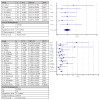Cemented versus Cementless Stem Fixation in Revision Total Knee Arthroplasty: A Systematic Review and Meta-Analysis
- PMID: 37998836
- PMCID: PMC10668853
- DOI: 10.3390/antibiotics12111633
Cemented versus Cementless Stem Fixation in Revision Total Knee Arthroplasty: A Systematic Review and Meta-Analysis
Abstract
The number of revision knee arthroplasties (rTKA) is growing significantly as is the use of intramedullary stems for optimized stability. The choice of the most appropriate stem fixation method is still controversial. The purpose of this meta-analysis is to compare cemented versus cementless stem fixation in rTKA. Publications with patients undergoing rTKA with a follow-up > 24 months were systemically reviewed. Extracted parameters included total revision and failure rates for any reason, incidence of aseptic loosening, periprosthetic infection, and radiolucent lines, as well as the clinical outcome. A statistical regression analysis was then performed on all extracted clinical and radiological outcome data. A total of 35 publications met the inclusion criteria and were included and analyzed. Overall, 14/35 publications compared cementless versus cemented stem fixation, whereas 21/35 publications investigated only one stem fixation method. There were no significant differences in revision (p = 0.2613) or failure rates (p = 0.3559) and no differences in the incidence of aseptic loosening (p = 0.3999) or periprosthetic infection (p = 0.1010). The incidence of radiolucent lines was significantly higher in patients with cemented stems (26.2% versus 18.6%, p < 0.0001). However, no differences in clinical outcomes were observed. No superiority of a specific stem fixation method in rTKA was found. Rates of revision or failure for any reason as well as incidence of aseptic loosening and periprosthetic infection in cemented versus cementless stem fixation showed no significant difference. A higher incidence of radiolucent lines was observed in cemented stem fixation; however, no effect was observed on the clinical outcome.
Keywords: cemented; cementless; clinical outcome; failure; fixation; revision; revision total knee arthroplasty; stem.
Conflict of interest statement
The authors declare no conflict of interest.
Figures








References
Publication types
LinkOut - more resources
Full Text Sources
Miscellaneous

